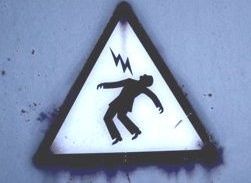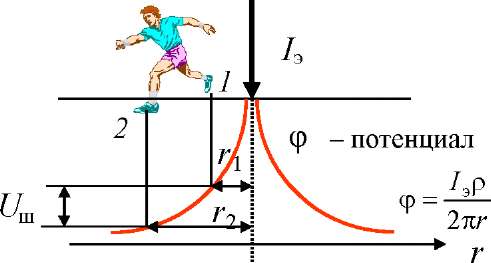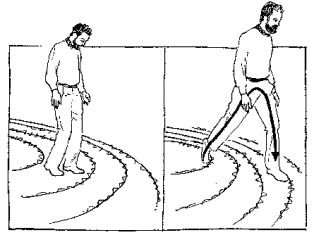Categories: Novice electricians, Safety precautions
Number of views: 65236
Comments on the article: 18
Step voltage and potential equalization
 Many of us from childhood remember that a bare tattered wire that fell to the ground is very dangerous. I remember various passions-muzzles about wet weather and about unfortunate victims who did not even have “happiness” to touch the metal, which was energized and caused their injury. All in all, they managed to pass in dangerously close to the damaged line - and this was more than enough.
Many of us from childhood remember that a bare tattered wire that fell to the ground is very dangerous. I remember various passions-muzzles about wet weather and about unfortunate victims who did not even have “happiness” to touch the metal, which was energized and caused their injury. All in all, they managed to pass in dangerously close to the damaged line - and this was more than enough.
But what kind of phenomenon is it, thanks to which a wire that lies “innocently” lying to one side becomes a deadly threat? Everyone knows that an electric shock to a person can only be caused by an electric current passing through his body. And electric current needs a clear path. At least two points of application on the body of the unlucky one are necessary: one of them is the phase from where the current can come, and the second is zero, where it can freely go.
But excuse me, what is the “phase"? Well, “zero” is still understandable, but where does the “phase” come from, if a person calmly walks on the ground and doesn’t even touch any wires? It seems that there is nothing like that - it’s just wet ground. A path, for example. Well, yes, the phase ragged wire lies nearby in the bushes. But he closed himself directly to the ground - the circuit does not include a pedestrian walking and the current should not go through it. But it only seems so.
There would be nothing to fear if the earth was an excellent conductor with a resistance close to that of a metal. Then a wire break and its fall to the ground would end with a banal short circuit.
The overcurrent protection would work, or the torn wire would burn, but in any case, this would not last long. But in reality, the electrical resistivity of the soil is at least 60 Ohm * m, and most often more, even if the weather is wet and it is raining. Therefore, when the cause breaks and it is shorted to ground for electric current, a new circuit simply arises: a phase wire - ground - a grounded neutral of the transformer.
Due to the not very high conductivity of the earth, the current has to work hard to get through this circuit, but it has no options. The current “would gladly take advantage” of some other, “parallel road,” which would allow him to shorten the path. And the pedestrian’s body can become so expensive.
Speaking scientifically, on the only significant resistance of the wire-ground-neutral circuit - wet soil - there is a voltage drop (change in electrical potential) from 220 volts near the fallen wire to zero at the transformer neutral.

This fall occurs non-linearly, but the point is that the closer to the wire, the more rapidly the potential of the earth increases. This means that the closer to the cliff point, the greater the potential difference between two surface points located at a certain distance. And an unfortunate passer-by can stand with one foot on the first of these points and with the other foot on the second of them. In this case, of course, he will take on the potential difference that has arisen, and this can turn out to be almost all phase voltage if the wire is close.
Of course, where the voltage appeared, the current there will not keep itself waiting. That's all. Not having time to realize the severity of his situation, a passerby receives an electric shock, possibly fatal.
The tension that occurs in such cases between the feet of a person is called "Step voltage" or “step tension,” and there are some measures to deal with it.
The most reliable of these measures is potential equalization. At the same time, the surface area of the soil, where an accident with a phase fault to the ground is possible, is equipped with a grid of grounded conductors laid directly below the surface.
It works very simply: the potential of the conductor at all points is always the same, so being on such a grid is simply impossible to get under voltage. Equalization of potentials is carried out on the territory of open switchgears (outdoor switchgear) and in other potentially dangerous places.
But, unfortunately, it is impossible to equip each transmission line support with a potential equalization grid. Therefore, every person who is not even an electrician needs to be vigilant: pay attention to the condition of power lines around you, especially in rainy weather. Pay attention to your feelings: if you are “pinched,” or even “shaken,” when walking, this is a fairly sure sign of the effect of step voltage.
Having understood that you are in the zone of possible impact of step voltage, you need to try to get out of it. But this must be done with a goose step - placing the heel of the foot that you are walking on to the toe of the foot on which you are standing. Thus, when walking, both legs will be practically at the same point with one electric potential - there will be no voltage between them.
You can also "jump" on one leg, if you are sure that you will succeed. You should not rush - you can stumble, fall on your hands and fall under the greatest possible tension that arises between two remote points.
See also at e.imadeself.com
:

